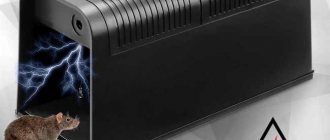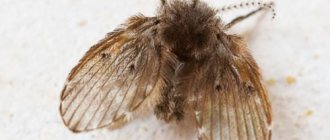Autumn is coming, it seems that you can relax, because parasitic insects have gone into hibernation and will no longer bother you with annoying buzzing and spoilage of food. However, with the arrival of cold weather, owners of private and country houses are faced with a new problem - rodents. Mice cause much more harm than insects, because they are very voracious and are also carriers of dangerous infectious diseases. You can remove mice using both folk and professional means.
In apartment buildings, mice are much less common, but still, residents of the first floor are periodically exposed to rodent infestations from the basement or from nearby landfills.
If you notice even one pest in an apartment or house, you need to immediately start fighting, because pests most often stick together in groups of several individuals and multiply quickly.
This article contains the most effective ways to get rid of mice.
Life activity and habits
Mice are often confused with rats, but they are very different from each other. Here are the main distinguishing features:
- Size. Mice are much smaller than rats - 6-10 cm. Therefore, it is easier for them to enter the house; infestations of these rodents are the most common.
- Habitat. Mice do not stray far from their nest, even to search for food. Therefore, they can appear even in a small apartment, unlike rats, which mainly appear in large, spacious houses.
- View. It is worth distinguishing between field and house mice. The latter live everywhere. Voles are smaller in size, live in fields, meadows, forests, destroying only garden plots and sometimes dachas.
- Physical features. Like rats, mice have a developed sense of smell, taste, and can develop quite high speed. But due to their small size, they can hide in the smallest cracks: they can easily crawl into a hole the width of a pencil. Rats cannot do this.
- Litter. Mouse excrement is very invisible, so many people do not immediately understand the reason for the unpleasant odor in their house or apartment. This leads to the fact that pest control begins too late, when they have already managed to reproduce.
Rats are almost not afraid of people and can even bite, while mice are more secretive. However, if pests continue to rule the house unhindered, they will become bolder, and over time they will begin to show themselves, running around in search of food.
Favorable habitats for mice are:
- Garbage dumps, landfills. Mountains of waste, in which pests find food, protection from the wind, and street animals, create excellent conditions for reproduction. Since landfills are usually located near apartment buildings, mice often get there.
- Abandoned buildings. Rodents are usually not in danger there. However, it is difficult to find food in empty houses, and pests go in search of neighboring ones.
- Heated premises. With the onset of the cold season, mice look for warm places with an abundance of food, where they can calmly wait out the winter. Such shelters are private houses, apartments, and warehouses.
- Products left within their reach are bait for rodents. Residents of private houses that have cellars and underground floors need to take care of installing good insulation that will prevent invasion.
Attention! Contrary to popular belief, mice do not eat cheese. Their food is cereals, seeds, and other plant products.
Nettle
At one time we had a plot of land with a large village house. There were many mice living there. One autumn, I laid out nettles in the rooms to dry them, take them to my Moscow apartment, and then brew the herb to strengthen my hair. Nettles lay on newspapers on the floor and table. When we arrived in the village in winter, we found no traces of mice. There were none in the spring either. Since then, every autumn I have laid out newspapers with nettles everywhere. I removed them at the end of spring. The mice no longer appeared in the house. The efficiency of this method is 100%.
House mouse (drawing from the Illustrated Encyclopedic Dictionary of Wildlife “Animals and Plants”)
Signs of mice in the house
If you live in a private house, you need to periodically inspect it for signs of rodents. First of all, you need to pay attention to attics, basements, storage rooms, underground floors, and heated garages.
Here are some signs by which you can understand that there are mice in the house:
- Rustles, squeaks, and other sounds of rodents moving behind walls, floors, and ceilings.
- Characteristic smell.
- Little paw prints on the floor.
- Chewed bags of cereals, pasta, seeds, and other foodstuffs.
- Traces of teeth on wiring, furniture, clothing.
- Burrows, holes in walls, wallpaper.
How to clean an outbuilding
Before you begin work in one of these structures, ventilate it for at least 30 minutes. As in previous cases, you will need gloves and disinfectant. Remove all mouse droppings, damaged items or bitten food items, nests and rodent carcasses. Spray disinfectant and wipe floors thoroughly. Place all traces of the presence of animals, the corpses themselves, rags and disposable towels in plastic bags and throw them in the trash. Spray the solution on the floors, walls and clean them. Clean desks, countertops, desks, cabinets or any other furniture that has marks or stains on it. Rodents have an easier time gaining access to outbuildings than to the home, so it is important to maintain the lawn and other vegetation that surrounds them. Since mice love to hide in secluded corners, you should get rid of everything unnecessary so that they do not have the opportunity to do so. Regularly trim bushes and remove leaves that fall in your yard.
Why are mice dangerous?
Mice reproduce very quickly: per year, one female brings about 70 offspring, which, in turn, also continue the race. In a short time, a colony of rodents can grow to enormous sizes, and removing it will be much more difficult.
Here are some reasons why you should get rid of pests on time:
- Mice in the apartment chew on wires from equipment, wiring, furniture, and clothes. In addition to the obvious damage to property, this poses a risk of fire, since uninsulated wires lead to a short circuit.
- Pests carry infections and diseases such as typhus, mouse fever, plague, tularemia, rabies, toxoplasmosis and many others. They are transmitted through bites, inhalation, eating contaminated foods, and pests living on rodents.
Bucket with water and bait
Several years ago in the fall, a mouse crawled into our basement. She entered through a slightly open window located at ground level. She was discovered only after her death from poisoning. The mouse spoiled plants sent for the winter, scattered cereal from bags and rendered things stored in the basement unusable. There was no way to catch the villain.
In a short time we have tried many methods of exterminating rodents. They even left a bucket of water in the basement, not filled to the very top. A light plastic plate with cereal and cheese was moored to its “shore”. According to the scenario, a hungry mouse had to climb up a plank to the edge of a bucket, climb onto a plate, start eating, and then fall into the water and not be able to get out of the bucket. The treat for her lay only on one edge of the plate, so that the dishes could turn over during the mouse's dinner. This ingenious method didn't work. Either the rodent was lazy or well-fed, so such a complex option for obtaining food did not interest him.
There is no need to waste time on such a clever structure. The efficiency of this method is minimal.
Effective ways to fight
To effectively remove all mice in the house, you need to choose a method depending on the specific case. For example, if they mainly live behind wallpaper, under floors, and ceilings, then poison is not the best choice. The smell of decomposition will linger in the house for a long time, and removing a corpse from such a hard-to-reach place is difficult.
Mousetrap
A mouse trap is great for removing rodents from your home. There are several tips that will allow you to most effectively destroy them:
- You need to install mousetraps in those places where mice run most often: bags of cereals, grain, holes in the walls, loopholes.
- In order for rodents to get used to someone else's unusual object, you should first set up uncharged mousetraps with bait.
- For an effective result, you need to place at least 7-10 traps.
The attractiveness of this method is that a person does not need to make efforts to destroy pests. However, mousetraps are not always effective: after several “victims,” rodents begin to be wary of the device, and we have to look for other methods.
Important! If a cat or dog lives in the house, you should not set mousetraps: the pet may accidentally fall into the trap. Of course, he is not in danger of death, but he will need a veterinarian's examination and treatment. It is also better not to use this method in an apartment with small children.
Poisonous baits
One of the most effective methods that will help remove mice from a private home is poison. It enters the rodent's body when eating bait, affects the digestive and nervous system, and causes internal bleeding. Poisoned individuals die within 2-7 days. It is important to periodically inspect the apartment and remove any found corpses. Otherwise, an unpleasant odor will appear.
Mice poison helps remove rodents in 95% of cases, especially if you spread it in several places and update it periodically.
There are many poisons that most effectively help remove the mouse population from the house, without causing much harm to humans:
- "Rat Death";
- “Help” bait;
- Ratron.
Attention! Before using the product, you must carefully read the instructions and follow all safety precautions. You should use poison extremely carefully if there are small children or animals in the apartment: they may accidentally eat a toxic substance, which will lead to severe poisoning.
Glue
You can also use glue to remove mice from your apartment. It is safer than poison, but more effective than mousetraps.
Now there are a variety of types of such means, but the principle of their action is the same. The cardboard strips are coated with a sticky layer that contains flavorings such as peanut butter, seeds, nuts, etc. Having sensed the bait, the mouse strives for it, but falls into the Velcro and is firmly glued. A similar method is used for fly strips.
You can purchase glue separately and spread it on those places where rodents are most often found: gaps between the wallpaper and the wall, holes near the floor or ceiling, etc. However, both house residents and pets can step into the sticky layer, so you need to be more careful when leaving such bait.
The following methods are popular for catching mice:
- "Rodentoff";
- "Kotofey";
- "Clean house".
Many people consider this method not too humane, because they will suffer trying to get out of the trap. You may have to look at the unpleasant sight of rodents tearing off their paws in vain hopes of avoiding a pitiful fate.
Ultrasonic repellers
Ultrasonic installations are modern, environmentally friendly means, the use of which does not require any effort and is also absolutely safe for people. They help remove all mice in 2-3 weeks, causing virtually no harm to them, so they are considered a fairly humane method. Ultrasound irritates the delicate hearing of animals, affects the nervous system, and they leave the house. The effect can be improved if you remove noise-absorbing items from the room: deep-pile carpets, upholstered furniture, curtains.
The following brands work well:
- "Tornado-200";
- "ElectroCat Turbo";
- "Chiston-2";
- "Tornado-800".
The downside of the repeller is that its signal does not pass through walls and other thick barriers, so you will need a separate device for each room. It is necessary to install ultrasound in all rooms, regardless of whether mice were noticed there or not.
Attention! Pets will suffer greatly from this method, because their hearing is also very sensitive.
Fighting with traps
Traps. The method of setting traps is allowed if there are no cats or dogs in the house. Traps can be factory-made (traps) or home-made. It should be taken into account that rats are very smart and careful.
Therefore, when setting a trap, in order to lull the animal’s vigilance, you need to place the bait on an unloaded trap a couple of times. Over time, the rat will stop paying attention to it and will easily fall into a trap.
The difficulty of the method is that one feels sorry for the animals that have slammed the trap and died in various unnatural positions. The corpses of animals caught in a trap should be removed away from the eyes of children and other impressionable family members. Therefore, the method is not suitable for everyone.
Electronic traps. Unlike traps, they are more hygienic. Their main advantage is that you do not have to remove the dead animal from the trap with your hands. It will be enough to simply empty the contents of the trap into the trash can.
Glue traps. Ideal for homes without cats. Many people cannot have a cat because one of their family members is allergic to fur. For such families, there is a way out in the form of a glue trap.
Several strips of glue are applied to a piece of cardboard or board, and bait is placed in the middle. Rats and mice that step on the glue cannot tear their paws off the cardboard.
They begin to break out and do not notice how they are glued to other parts of the body. In this position they are forced to lie and await their further fate.
Someone then throws the cardboard with glue and the animals stuck to it into the trash can, where the cats are waiting. Someone gives it to the neighbor's cat. Fortunately, the glue is non-toxic and nothing will happen to a cat that eats such a rat or mouse.
Homemade traps. Some craftsmen make traps themselves, using jars, bottles and other improvised items.
They make a trap in such a way that an animal that gets caught in it cannot get back out. Something piercing will prevent him from getting out and the unfortunate rodent will have to sit there until he dies or until people discover him.
When using a rodent trap, you should know that a rat caught in the trap will make warning sounds for its relatives. Therefore, no more rats will fall into the trap in this place. You will have to change the location of the trap every day to catch the next pest.
Alternative Methods
There are other, less traditional ways to get rid of pests. Their effect extends only to a small colony of mice. These methods are effective in the first stages of control and are effective for a small colony of rodents.
Cat
Of course, now furry pets are kept mainly for beauty and peace of mind, but modern cats differ little from those that lived several decades and even hundreds of years ago. They are forced to hunt mice by instincts that do not change over time, but can only be dulled by a well-fed life.
A “comrade in arms” will quickly deal with a small population if you launch it into a house. Cats and cats that roam freely on the street can periodically bring mice to their owner as a gift as a sign of respect. Also, the cat smell itself repels rodents from the home.
Scented herbs and oils
Mice cannot tolerate the smells of mint, chamomile, and wormwood. These herbs must be distributed throughout the house. You can use fragrant extracts and essential oils, pouring them into small flat plates and placing them around the perimeter of the apartment.
How to catch rodents in your HVAC system
One of the most common habitats for rodents is the HVAC (heating, ventilation and air conditioning) system, where rats and mice can enter through cracks around roof vents. When rodents invade, the smell of their urine spreads throughout the house. And if the animals die there, it becomes almost impossible to stay indoors. To solve this problem, use our tips:
- turn off the HVAC system and remove the grilles from the vents;
- place peanut butter or other bait in the traps, place them inside and secure the vents;
- Check the traps daily until no one is caught in them for a week.
- put on gloves, treat the area with a disinfectant, and place the dead rodent and its droppings in two tight bags.
To prevent rodents from entering the air duct, it is worth sealing holes and cracks. To do this, inspect the outside of the house and if you see any gaps around the exterior vents, fill the gaps with caulk. In some cases, you will need professional help to clean your ventilation ducts more thoroughly.
For best results, use the traps that are presented on our website. We have a solution that is perfect for you. We offer all types of traps from leading manufacturers. The excellent quality of the devices has been repeatedly proven in practice.
Mice only at first glance seem like cute, small and harmless animals. In fact, these rodents cause destruction: they damage household appliances, furniture, wiring, contaminate food, and are carriers of dangerous infections. Their specific smell is absorbed into clothes and bedding; squeaking and rustling in the evenings interfere with sleep. If these little pests are bothering you, use these tips and find out how to get rid of mice in your apartment. The most effective ways to control rodents are described below.
Traditional methods
Rodents have long bothered people and caused a lot of trouble, and previously the destruction of crops meant famine. There were no special poisons to combat this scourge, so people invented ways to remove mice, which still do not lose their relevance. Here are some of them:
- Ash. It corrodes the paws of rodents, so they try to stay away from it. Ash should be scattered on the floor near the minks and around food.
- A mixture of flour and sugar. Having eaten it and washed it down with liquid, the mouse dies from blockage of the passages of the digestive system. Sugar can be replaced with gypsum, which will give a better effect.
- Naphthalene or ammonia. Both products have a strong, repulsive odor and act like essential oils.
Features of working in a pigsty
A popular place for rats to live is a pigsty; it is difficult to drive pests out of it.
Attention! Before eliminating rats in a pigsty, you need to consider the actions and consequences that may occur.
When choosing chemicals to get rid of rats in a barn with pigs, you need to make sure that the poison does not penetrate into the feeder. Otherwise, the pig and even an adult pig may die. Using this option, you need to provide a procedure for getting rid of the smell coming from the corpses of rats.
Advice! A safe way is to use home recipes.
- Sprinkling ash on the pigsty floor.
- Placing foul-smelling herbs.
- Use of special glue.
How to get rid of the smell of mice in the house?
Often, the corpse of a mouse or its droppings leaves a very unpleasant odor, which causes inconvenience to residents and guests of the house. It can be quite difficult to get it out. There are several ways to do this:
- Ventilation. This is the simplest but most effective method to remove the unpleasant odor. It is necessary to leave all windows and doors open for 3-4 hours.
- Wash. This method will help if traces of mouse droppings are found on clothing. It is necessary to wash the contaminated item separately from others at the highest permissible temperature with the addition of conditioner.
- Vacuum cleaner. Carpets should be cleaned with a household unit with a wet cleaning function. Anything that cannot be washed by hand must be taken to the dry cleaner.
- Chlorine-containing products. Surfaces must be cleaned using white. However, you should not use bleach if there are small children in the house.
- Manganese solution. The substance must be diluted in water so that it turns light pink (about 10 crystals per 1 liter), then wipe all surfaces with the resulting liquid. The solution will help remove the smell of mice, clean the room from traces of rodents, and disinfect it. The persistent “aroma” of potassium permanganate will repel rodents and prevent further attacks on your home.
Tips and tricks
When cleaning up any traces of a mouse, do not sweep or vacuum up droppings, fur, or the area where the mouse is located. This will cause dust to rise, and pathogenic microorganisms can get onto your skin and into your respiratory tract. Instead, soak all trash with this solution: 10% bleach to 90% water. Then wipe the floor clean. It is important that all areas are cleaned of germs and the source of unpleasant odors. As you prepare and clean, follow these steps:
- Protect your hands and wear latex or rubber gloves.
- Spray the disinfectant onto the rat or mouse droppings and leave for at least five minutes.
- Remove excrement with paper towels and dispose of it in plastic trash bags. Once everything is cleaned, reapply the disinfectant.
If there is evidence that rodents have crossed into other parts of your home, those areas are also thoroughly disinfected. Eliminate any marks, streaks or marks in your home. Disinfect and wash sheets and any fabrics containing rodent droppings or urine, and steam clean carpets or upholstery. After you finish disinfecting items in your home, wash your hands with gloves. Then throw away the gloves and clean your hands with alcohol or wash them with soap.
Prevention measures
To prevent a mouse infestation, several rules should be followed:
- Clean regularly and throw away trash promptly.
- In a private home or country house, food supplies and sources of standing water should be kept away. On a personal plot, you also need to periodically get rid of organic debris and plant debris.
- In the fall, check hard-to-reach places in your apartment or house for mouse traces.
- Carefully inspect the walls, floors, and ceilings of all buildings on the site. If holes or openings are found, they must be sealed immediately.
- You can plant herbs around the house whose smells mice cannot tolerate.
How to determine where rats enter premises?
It is necessary to walk around the perimeter of your house and carefully inspect the foundation, blind areas and walls for cracks and holes. Defects found should be eliminated. You can do this by plastering with gypsum or alabaster.
If the plans include insulating the walls of the house and covering it with siding, then it is better to use glass wool insulation. It contains tiny particles of glass and animals do not touch it.
You can also use folk remedies to prevent rats from entering your home. You can add fish oil or naphthalene to the mixture of plaster or alabaster, or spread these products on possible crevices from which rodents can enter.
If rats have already entered the house, their presence can be easily detected. An unpleasant specific mouse smell will appear, rat excrement will be noticeable in places, and sometimes their sounds will be heard - squeaking, squealing, grinding. In this case, measures will be needed to kill or repel rats.
What to do with bats?
What to do with bats if they fly into your house? It is not recommended to kill them for several reasons:
- Many species of bats are listed as endangered in the Red Book.
- Animals are carriers of diseases.
You need to carefully cover the animal with a towel or any cloth, take it and throw it out the window. You can use a broom and dustpan. The bat is very poorly oriented in a bright room; it is likely that it will try to hide in the darkest possible place. You should not harm the animal; folk signs say that in this case, misfortune awaits the person.
Attention! Bats usually fly indoors for warmth. It is advisable to keep the windows closed if there is a high population of these animals in the area.
Rodents in the apiary
Rodents in the apiary are a real disaster. They cause many problems:
- They eat bee food reserves for the wintering period, and sometimes the bees themselves:
- they gnaw holes in the honeycombs, making their further use impossible;
- leave a peculiar smell that causes bees to fly away;
- They constantly make noise, especially after breeding, which causes discomfort to the bees.
The first thing that is necessary in the fight against mice in the apiary is to make high-quality hives. It is necessary to seal all the holes, install metal sheets on the doors and the lower part of the hives. Before the cold weather, broken houses need to be repaired, mouse holes, if any, need to be sealed.
Methods for controlling mice in hives include:
- Installation of mousetraps and bait traps. They can be purchased or made with your own hands.
- The use of poisons that instantly kill rodents, for example, thallium sulfate, zinc phosphide, fluoroacetamide.
- The use of poisons that have a cumulative effect, for example, fumarin, ratindane, zoocoumarin.
- Planting rodent repellent plants around hives. Such plants include red elderberry, chamomile, coriander, spruce, and mint.
- Using leaves and green peels of walnuts or black root, which can drive away rodents.
Important! Any poisons must be mixed with baits. In this case, a 3% concentration of poisons is sufficient. The bait can be grains, lard, dough, sausage.











